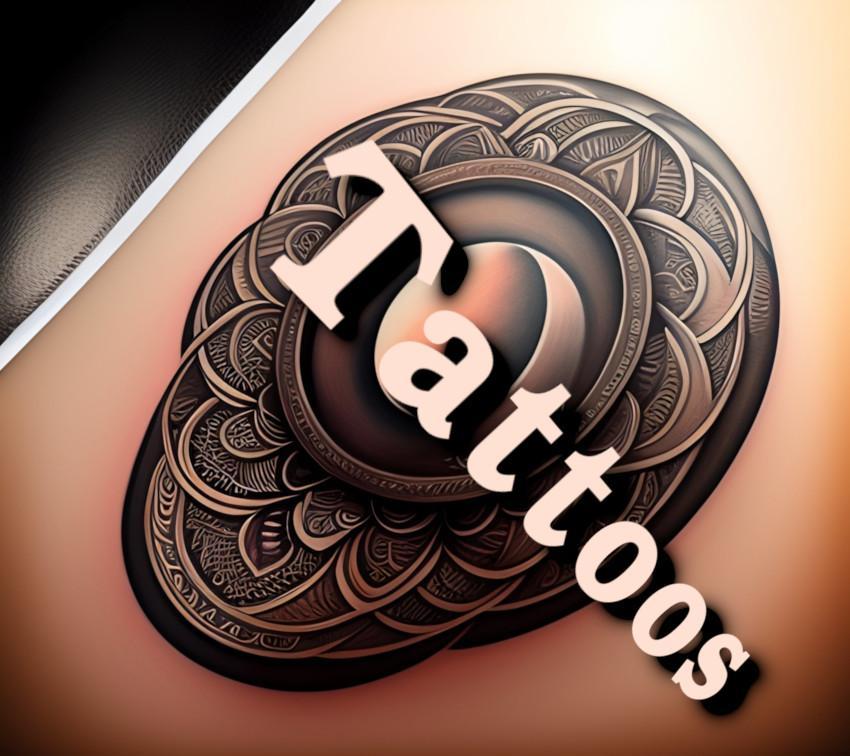


Tattoos have transcended their historical roots to become powerful forms of self-expression, telling unique stories on the canvas of our skin. Behind each intricate design lies the skill and artistry of tattoo artists, individuals who transform ideas into permanent works of art. In this comprehensive guide, we'll explore the world of tattoos and tattoo artists, shedding light on the diverse aspects of this art form and offering valuable tips for those considering getting inked.
The Art of Tattooing:
Tattooing is an ancient art form that has evolved into a contemporary means of self-expression. From traditional tribal designs to modern illustrations, tattoos have become a significant aspect of personal identity and creativity.
Choosing the Right Tattoo Artist:
Selecting the right tattoo artist is paramount to a positive tattooing experience. Research local artists, explore their portfolios, and read reviews to gauge their expertise and style. Attend tattoo conventions or visit reputable studios to find an artist whose work resonates with your aesthetic preferences.
Understanding Different Tattoo Styles:
Tattooing encompasses various styles, each with its unique characteristics. From traditional and realistic to watercolor and geometric, understanding different styles helps you communicate your vision effectively to your chosen artist.
Tattoo Design and Personalization:
Collaborate with your tattoo artist during the design process. Provide inspiration, discuss symbolism, and share any specific elements you want to include. A personalized approach ensures that the tattoo reflects your individuality and holds personal meaning.
Placement Considerations:
Consider the placement of your tattoo carefully. Different areas of the body have varying levels of pain sensitivity, and the longevity of the tattoo may be influenced by factors such as skin type and exposure to the elements. Consult with your tattoo artist to determine the best placement for your design.
Health and Safety:
Prioritize health and safety when choosing a tattoo artist and studio. Ensure the artist follows strict hygiene practices, including the use of sterilized equipment and disposable needles. Verify that the studio meets health regulations and that the artist is licensed.
Tattoo Aftercare:
Proper aftercare is essential for the healing and preservation of your tattoo. Follow the aftercare instructions provided by your tattoo artist, which may include keeping the tattoo clean, moisturized, and protected from direct sunlight during the initial healing phase.
Dealing with Pain:
Pain tolerance varies among individuals, and the perception of pain during tattooing is subjective. Prepare mentally for the process, stay hydrated, and consider factors such as fatigue and stress, which can influence pain sensitivity. Communicate openly with your tattoo artist about any concerns.
Tattoo Touch-ups and Maintenance:
Over time, tattoos may experience some fading or require touch-ups. Follow up with your tattoo artist for any necessary maintenance. Protect your tattoo from excessive sun exposure and consider using sunscreen to preserve the vibrancy of the colors.
Communication and Trust:
Establish open communication with your tattoo artist. Convey your expectations, ask questions, and express any concerns you may have. Building trust with your artist is crucial for a collaborative and successful tattooing experience.
Researching Tattoo Removal Options:
While tattoos are considered permanent, advancements in technology have led to various tattoo removal options. If you're considering a tattoo, also research removal techniques in case circumstances change in the future.
Celebrating Tattoo Diversity:
Embrace the diversity of tattoo artistry and styles. Tattoos are deeply personal expressions, and each design carries a unique story. Respect the choices of others and celebrate the rich tapestry of tattoos as a form of art and self-identity.
Tattooing has a rich and varied history that spans cultures and civilizations around the world. Here is a brief overview of tattoo culture and history:
Ancient times: Tattoos have been found on mummies dating back to around 3,000 BCE in ancient Egypt, and have been found on mummies from other cultures as well. In ancient Greece and Rome, tattoos were often used to mark slaves or criminals.
Polynesia: Polynesian cultures have a long tradition of tattooing, with designs that represent social status, family history, and spiritual beliefs. Tattoos were often created using traditional hand-tapping methods and covered large areas of the body.
Japan: In Japan, traditional tattoos known as irezumi were often full-body designs that incorporated Japanese folklore and mythology. These tattoos were historically associated with criminal or gang activity, but are now more widely accepted.
Western culture: In the 19th and early 20th centuries, tattoos were popular among sailors and soldiers, who often got tattoos to commemorate their travels or military service. In the 1960s and 70s, tattoos became associated with counterculture movements like hippies and punk rockers and began to gain wider acceptance as a form of self-expression.
Contemporary culture: Today, tattoos are widely accepted as a form of self-expression and are popular among people of all ages and backgrounds. Tattoos can be used to commemorate important life events, express personal beliefs or values, or simply as a form of art.
United States: Tattoos have become increasingly popular in the United States in recent decades, and are now widely accepted as a form of self-expression. Some people get tattoos to commemorate important life events or express their individuality, while others may view them as a form of rebellion or counterculture.
Middle East: Tattoos are generally not accepted in many parts of the Middle East, as they are associated with non-Islamic cultures or criminal activity.
Africa: In some African cultures, tattoos are used as a form of tribal identification or to mark important life events like puberty or marriage.
Tattoo culture varies widely around the world and throughout history. In some cultures, tattoos are considered a symbol of beauty, strength, or cultural identity, while in others they may be associated with criminal or marginalized groups.
Attitudes towards tattoos vary widely around the world and are influenced by cultural, social, and religious factors. While tattoos have become more widely accepted in many parts of the world, there are still some areas where they are stigmatized or viewed negatively.
There are many different types of tattoos, each with its own unique style and meaning. Here are some of the most common types of tattoos:
Traditional tattoos: Also known as "old school" tattoos, these are typically bold and colorful designs featuring images like anchors, eagles, and hearts.
Realism tattoos: These tattoos are designed to look like a photograph or a realistic depiction of an object, person, or animal.
Watercolor tattoos: These tattoos feature a style that looks like a watercolor painting, with soft colors and blurred lines.
Geometric tattoos: These tattoos feature geometric shapes and patterns, often in black ink.
Blackwork tattoos: These tattoos are done entirely in black ink and often feature intricate patterns and designs.
Tribal tattoos: These tattoos feature designs inspired by traditional tribal cultures, often featuring bold lines and dark shading.
Fine line tattoos: These tattoos feature delicate, thin lines and minimal shading, creating a subtle and elegant look.
Neo-traditional tattoos: These tattoos combine traditional tattoo styles with modern elements, often featuring bold colors and intricate designs.
Japanese tattoos: Also known as irezumi, these tattoos feature traditional Japanese designs like koi fish, dragons, and samurai warriors.
Lettering tattoos: These tattoos feature words or phrases, often in script or calligraphy style.
When it comes to finding a reputable tattoo artist and tattoo salon, there are several factors to consider. Here are some tips for researching and reviewing tattoo artists and salons:
Look for reviews and ratings: Online reviews and ratings are a great way to get an idea of the quality of a tattoo artist or salon. Check out sites like Yelp or Google Reviews to read what other clients have to say about their experiences.
Check out their portfolio: A reputable tattoo artist or salon should have a portfolio of their work available for you to review. This can give you an idea of their skill level and the style of tattoos they specialize in.
Ask for recommendations: If you have friends or family members with tattoos you admire, ask them for recommendations on tattoo artists or salons they have used.
Visit the salon in person: Before committing to a tattoo artist or salon, consider visiting in person to get a feel for the environment. Look for cleanliness, professionalism, and friendliness of the staff.
Ask about their sterilization practices: It's important to choose a tattoo artist or salon that takes sterilization seriously. Ask about their sterilization practices and make sure they use disposable needles and equipment.
Discuss your design ideas: When meeting with a tattoo artist, make sure you discuss your design ideas in detail to ensure they understand your vision and can deliver the tattoo you want.
Consider the cost: While you don't want to sacrifice quality for a cheaper price, it's important to consider the cost of a tattoo when choosing an artist or salon. Make sure you are comfortable with the price before committing.
Take your time when researching and choosing a tattoo artist or salon. It's important to find someone you trust to give you a tattoo you will love and cherish for years to come.
While tattoos can be a beautiful form of self-expression, there are some common problems that can arise with tattoos or tattoo artists. Here are a few:
Allergic reactions: Some people may have an allergic reaction to the ink used in tattoos, causing redness, itching, or swelling. This is more common with red ink or pigments containing nickel.
Infection: Poor sterilization practices or dirty equipment can lead to infection in the tattooed area. Symptoms can include redness, swelling, and pus.
Misspelled words or incorrect designs: It's important to carefully review the design and spelling of a tattoo before it is inked onto the skin. Unfortunately, mistakes can happen, and they can be difficult or impossible to fix once the tattoo is complete.
Poor-quality tattoos: Not all tattoo artists have the same level of skill or experience, and some may produce poor-quality tattoos. This can include uneven lines, blurry designs, or tattoos that don't match the intended design.
Fading or blurring over time: Even well-done tattoos can fade or blur over time due to sun exposure, aging, or other factors.
Communication issues: It's important for clients to communicate clearly with their tattoo artist to ensure that the design and placement are exactly what they want. Miscommunications can lead to dissatisfaction with the final result.
When performed by a licensed and experienced professional in a sterile environment, tattoos are generally considered safe for most people. However, there are some potential health risks associated with getting a tattoo, including:
Infection: If the tattoo equipment or environment is not properly sterilized, there is a risk of bacterial, fungal, or viral infection. Signs of infection include redness, swelling, pain, and pus.
Allergic reactions: Some people may have an allergic reaction to the ink used in tattoos, causing itching, redness, and swelling. Allergic reactions can occur immediately or years after getting the tattoo.
Bloodborne diseases: If the tattoo equipment is not properly sterilized, there is a risk of transmitting bloodborne diseases like hepatitis B or C, HIV, or tetanus.
Scarring: In some cases, scarring or keloid formation can occur after getting a tattoo.
MRI complications: Tattoos can sometimes cause complications during magnetic resonance imaging (MRI) scans due to the metal content of the ink.
To minimize these risks, it's important to choose a reputable and experienced tattoo artist, carefully follow aftercare instructions to prevent infection, and inform your healthcare provider if you have a tattoo before undergoing an MRI. If you have any concerns about getting a tattoo, you should talk to your healthcare provider.
Throughout history, tattoo culture has been influenced by social, cultural, and religious factors, and has been both celebrated and stigmatized. Today, tattoos continue to evolve and reflect changing attitudes and beliefs around the world.
Tattoos are enduring symbols of personal expression, with each design representing a chapter of one's life. By choosing the right tattoo artist, understanding different styles, and prioritizing health and aftercare, individuals can embark on a transformative journey of self-expression and artistry. Remember, a tattoo is not just ink on skin; it's a canvas that encapsulates memories, beliefs, and the essence of who you are.
Sincerely yours,

We use cookies
We use cookies and other tracking technologies to improve your browsing experience on our website, to show you personalized content and targeted ads, to analyze our website traffic, and to understand where our visitors are coming from. Privacy Policy.